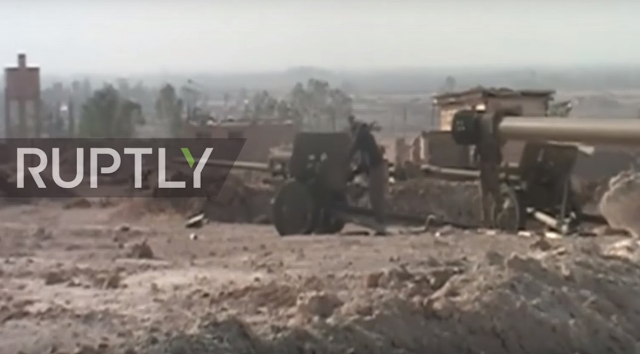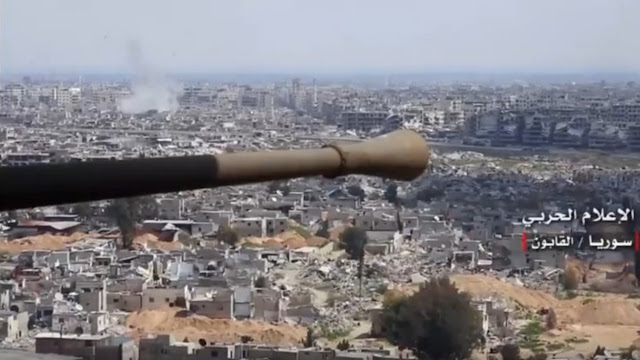The war in Syria has seen weapons from all over the world being tested in combat. Russia and Iran have tested out their weapons in the field, including drones and unmanned ground vehicles. However, older weapons still see heavy use in the fields, deserts and mountains of Syria. This article will focus on these older WWII era weapons.
The StG-44 is considered to be the world's first assault rifle. It was created by Nazi Germany in 1943 originally against Hitler's wishes. After the war, the soviets sent many captured weapons to its client states. Syria received thousands of StG-44s among other weapons. 5,000 StG-44s fell into rebel hands in Aleppo in 2013 after a Syrian army base was overrun. The rebels likely didn't know what they had at first, thinking them strange AK-47s. They were apparently popular, but the rare 7.92X33mm ammunition quickly ran out, and their use stopped by 2014.
A rebel firing an StG-44 in Aleppo, 2013 or early 2014.
Another rebel StG-44 in action in Aleppo, 2013.
A plethora of StGs for sale in Idlib.
The Soviet WWII counterpart should not be forgotten. The very well known PPSh-41 submachine gun seems to have been used very mildly in Syria compared to the StG-44. It was seen in the hands of soldiers in Deir Ezzor but it is unknown if it saw actual combat.
A Russian soldier with a PPSh-41 in Palmyra, 2016.
A Syrian soldier with a PPSh-41 in besieged Deir Ezzor.
Another Nazi weapon which was apparently used in the Syrian civil war was the K98K rifle. Three examples seen below captured from ISIS by the YPG.
WWII artillery and anti-tank guns saw heavy use in the Syrian civil war. Most of this use came from the SAA, rebels would use some artillery but mostly captured cold war era D-30s and M-46s. There is one notable exception to this.
Rebels using a LeFH 18 10.5 cm Howitzer produced by Nazi Germany on the besieged town of Fuah in Idlib province in 2015. This howitzer was looted from an SAA base, but it is unclear exactly which one. The SAA was never filmed using this howitzer.
Loading a 10.5 CM (105mm) shell.
Firing on the besieged Shia town of Fuah, Idlib province.
The SAA used the Soviet ZiS-2 57mm anti-tank gun and ZiS-3 76mm on several documented occasions. ZiS-2s were far more commonly used, with ZiS-3s only known to have been used against ISIS in Deir Ezzor.
An SAA soldier with a ZiS-2.
A ZiS-2 technical that was used during the battle of Aleppo in 2016 by the SAA.
ZiS-2 bunker position in East Ghouta, Damascus filmed by rebels.
A ZiS-2 and ZiS-3 at an artillery position between Deir Ezzor city and Airbase that was used to shell ISIS as they tried to advance.
The ML-20 152mm howitzer was the bane of Nazi Germany's existence. The Soviet howitzer crushed them when encountered throughout WWII and finished them off during the battle of Seelow Heights and the Battle of Berlin.
An ML-20 firing on ISIS in the Homs desert.
An ML-20 with many spent shell casings in the Homs desert.
An SAA soldier prepares to fire an ML-20.
A smaller howitzer used by the Soviets and then the SAA was the M-1938 122mm Howitzer.
An M-1938 firing in Latakia province on rebel positions.
Another M-1938 firing. A cold war era D-30 122mm is in the background.
The M-1939 37mm anti-aircraft gun was developed by the Soviet Union and saw heavy action against the Luftwaffe. Over 14,000 Axis planes were claimed shot down by the 37mm gun during WWII. The SAA Used the M-1939 against ground targets both stationary and on mobile technicals. Syria was listed as having 300 M-1939s at the start of the war.
The only users to operate the M-1939 as anti-air platforms were ISIS and the Syrian rebels. ISIS is seen here shooting at the Syrian air force (SyAAF) in Eastern Aleppo province in 2017.
Of course WWII weapons wouldn't be compete without tanks and tank destroyers. While there were no recorded instances of any WWII era armored vehicle being used in combat in Syria, several derelict examples were pictured.
A T-34-85 and a Panzer IV in the 1950s. Over 100 Panzer IVs were sold to Syria by France in the 1950s. It was modified to hold a DShK 12.7 heavy machine gun on the commander's cupola. No Panzer IVs are known to survive in Syria today. Several can be seen that were knocked out in the Israeli occupied Golan Heights during the Six Day war.
A T-34-85 on the Golan Heights border once used as a static pillbox.
Another static, but well maintained looking T-34-85 on the Golan border with Russian soldiers.
A possibly operational T-34-85 with SAA soldiers in the desert. It is unclear if it saw actual combat, but is unlikely.
A T-34-85 monument in an SAA base.
The StuG III was the most produced armored fighting vehicle of Nazi Germany, with some 11,000 being built. It's low profile and capable 75mm gun made it one of, if not the most successful armored fighting vehicle of Nazi Germany. It was based on the chassis of the Panzer III, so it didn't suffer mechanical breakdowns like later, heavier German tanks and tank destroyers. At least 30 StuGs were sent to Syria after WWII where they saw combat in the Six Day war.
A Syrian StuG III pictured in the 1950s.
A derelict SAA StuG-III near the Golan Heights.
While there are no photos from recent times of a Syrian Jagdpanzer IV, Syria operated them and had them in storage until recently. Syria received six Jagdpanzers, with one being knocked out during the Six Day war. It is possible that five of them are still in storage in Northern Damascus, as they were listed as being in storage as late as 1991. A Jagdpanzer IV pictured on the move in the 1950s.

















































No comments:
Post a Comment